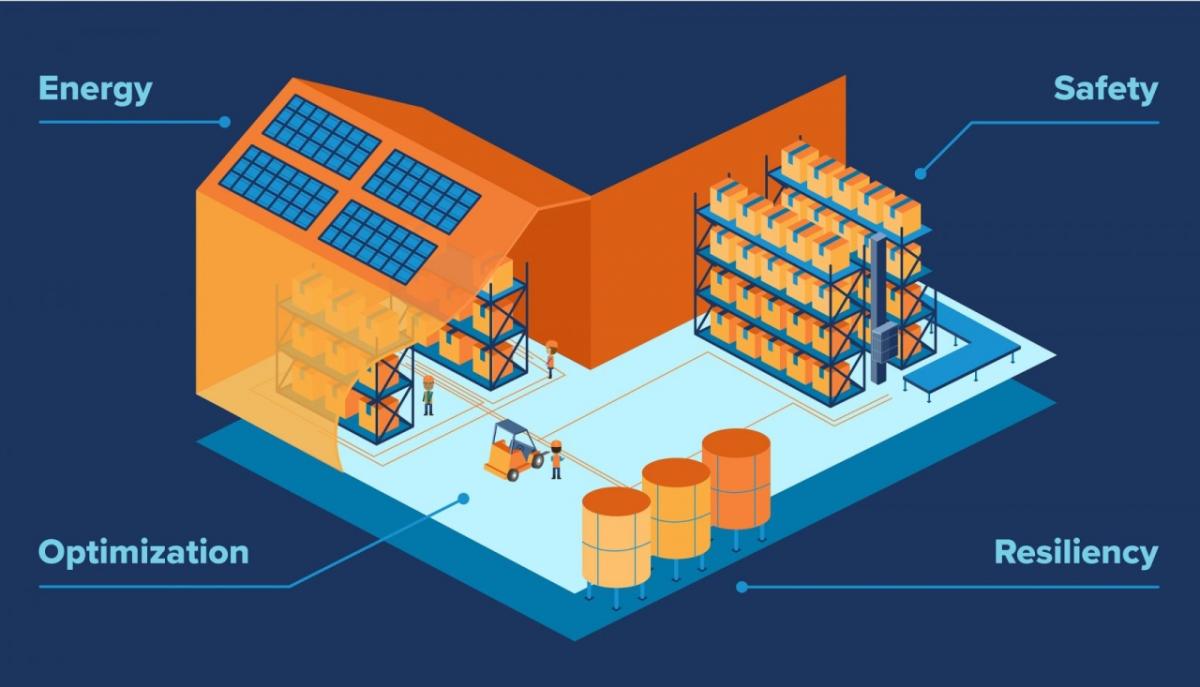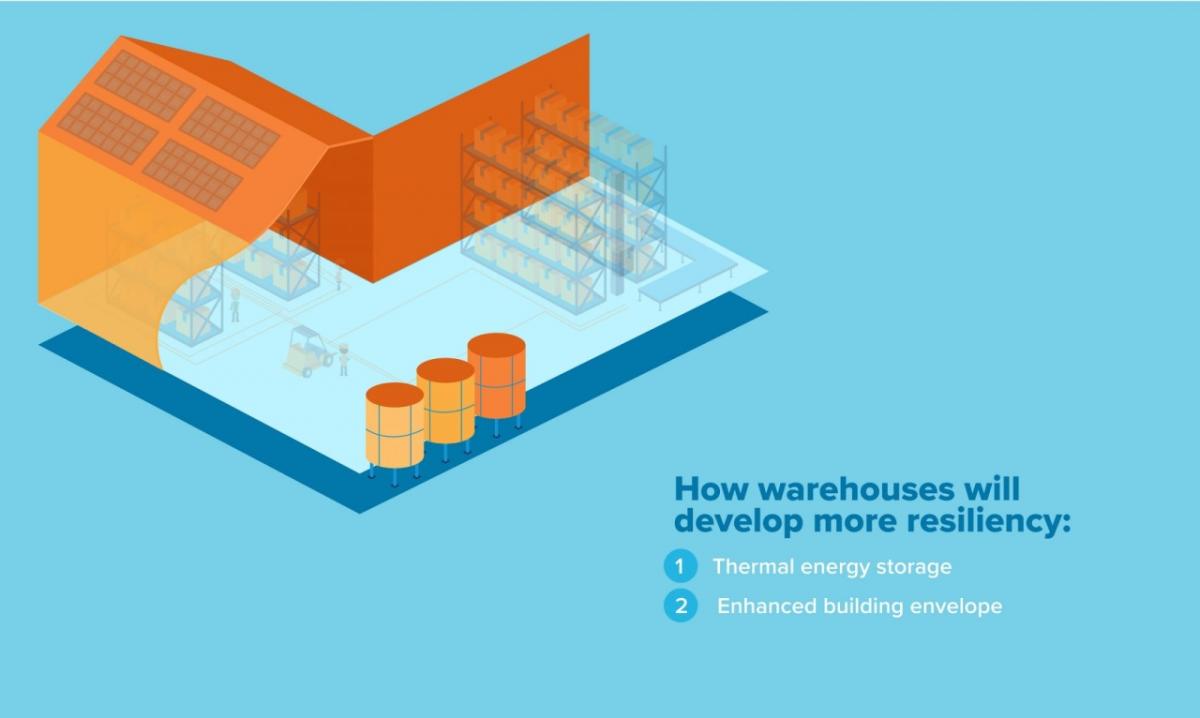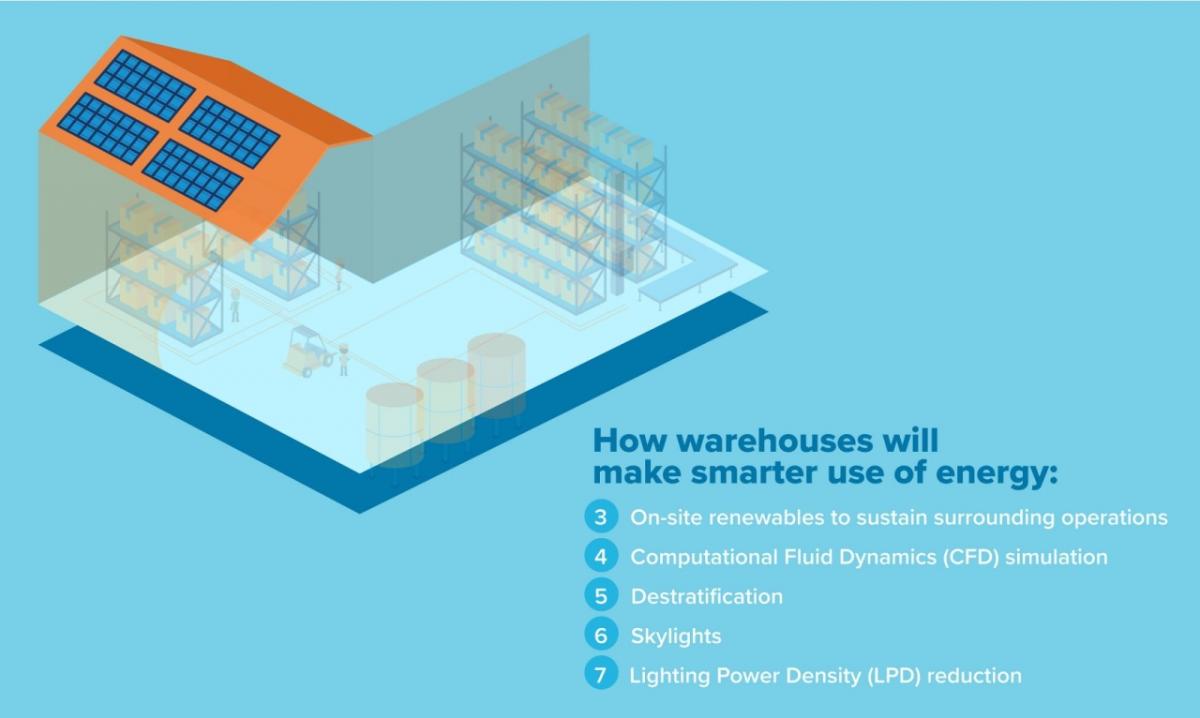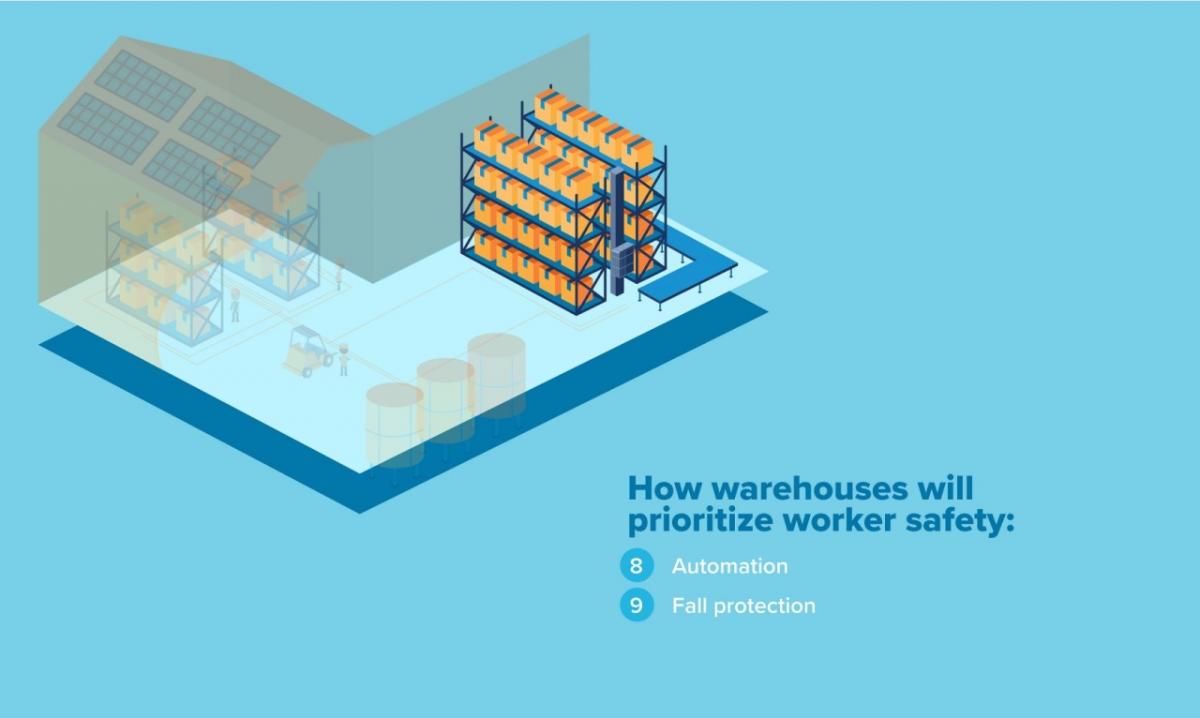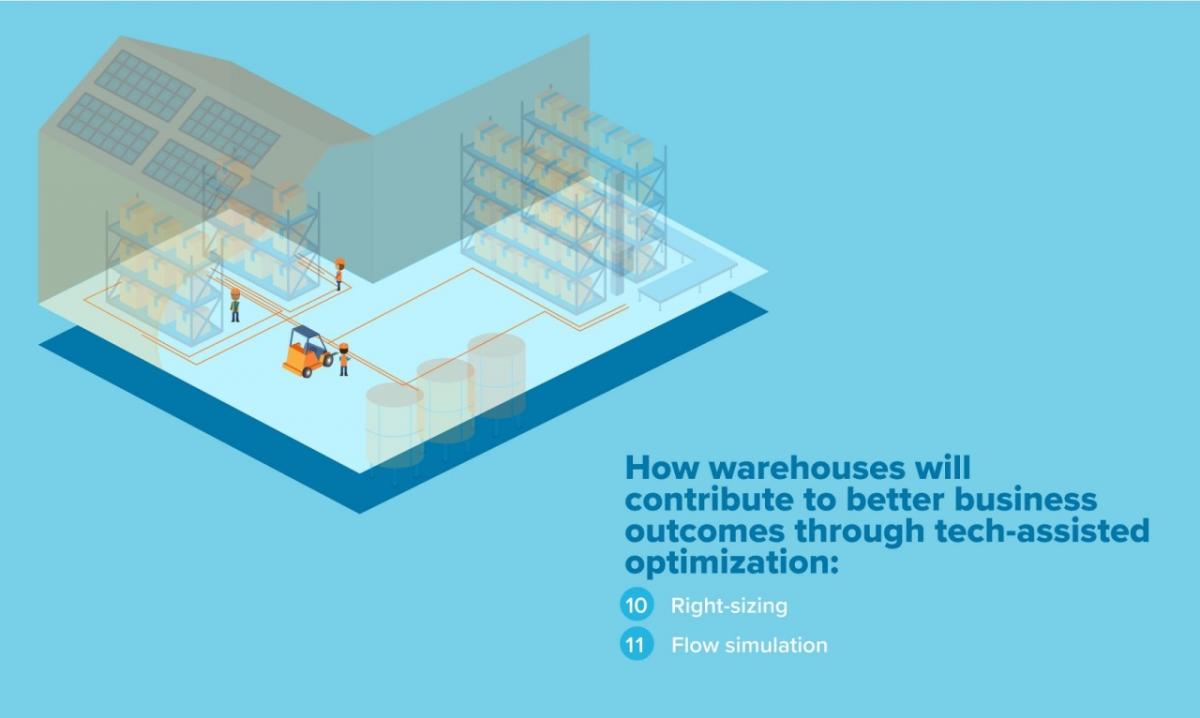Warehouse Layout Ideas for a Sustainable Future
How can we design resilient and sustainable warehouse layouts that are ready for another thirty years of rapid change?
Picture yourself stepping into a warehouse, circa 1990. What do you see? Low racking separated by aisles wide enough to accommodate a superhighway of operator-driven forklifts. You see paper too, and lots of it: a clipboard in every hand, a stack of physical records around every corner. And how about what you feel—or rather, what you don’t? No climate control. Very little ventilation.
Looking back, it’s easy to spot these risks and inefficiencies and to appreciate how far we’ve come thanks to improved technology and shifting marketplace dynamics. But what about looking ahead? How can we design resilient and sustainable warehouses that are ready for another thirty years of rapid change?
Our most useful tool in answering these questions is one that is not typically associated with warehouse layout design—at least, not yet: sustainability.
Holistic sustainability: a definition
For many, sustainability evokes “going green.” That idea may be correct, but it’s not complete. Holistic sustainability is about more than environmental initiatives and corporate responsibility. It’s about protecting product quality, ensuring employee safety, and ultimately driving ROI. The best way to think about it is to borrow from the notion of “ESG”:
ESG: Reduce your environmental impact and protect societal wellbeing, all while improving business outcomes through good corporate governance.
Forward-thinking company leaders know this. That’s why we’re beginning to see sustainability initiatives expand beyond strictly energy-dense areas of operation, like manufacturing. End-to-end sustainability, inclusive of the warehouse, is the way of the future, particularly when that future is defined by supply chain uncertainty and turbulent market conditions.
We see this sustainability agenda driving change in the warehouse across four key areas:
- Warehouses will develop more resiliency
- Warehouses will make smarter use of energy
- Warehouses will prioritize worker safety
- Warehouses will contribute to better business outcomes through tech-assisted optimization.
How warehouses will develop more resiliency
1. Thermal energy storage
The big idea: By storing thermal energy for future use, warehouse operators will improve their cost control while better managing their ongoing risks.
- For example, operators might deploy a system that uses Phase Change Material (PCM) to capture and release energy efficiently as it freezes and thaws.
- Capturing energy during off-peak hours means avoiding the cost of “peak hour” energy consumption.
- Stored energy provides a means for “riding out” a short-term utility interruption without adversely affecting product quality.
2. Enhanced building envelope
The big idea: The more a warehouse is sealed and insulated like an igloo, the more thermal energy it can store for future use.
- New and improved solutions will emerge to eliminate energy “leaks,” such as air curtains applied to overhead doors and automated pressurization to force appropriate air exfiltration in designated areas.
- Companies that go beyond the “code minimum” to better insulate their warehouses are likely to see a rising ROI supported by lifetime energy savings.
- Climate-specific solutions will play an increasingly important role in supporting product quality within the warehouse.
- Along with overall improvements to the building envelope, operators will seek out small but cumulative opportunities to reduce energy, such as demand control ventilation or modified internal temperature setpoints.
How warehouses will make smarter use of energy
3. On-site renewables to sustain surrounding operations
Because it typically consumes far less energy than other building functions, the warehouse isn’t always a priority area for energy reduction initiatives. But what about energy production?
- By installing solar photovoltaic (PV) systems on the warehouse, operators can turn an idle asset (the roof) into a valuable generator of renewable energy, which can then feed adjacent building functions.
- As PV systems grow in popularity, new business models are emerging to help companies finance their installation and maintenance. For example, a warehouse might lease its rooftop PV system to a third party, then buy back the electricity it generates at a special low rate.
4. Computational Fluid Dynamics (CFD) simulation
The big idea: All areas of warehouse operations will become “smarter,” giving operators the data-backed insights they need to take decisive action. This is especially true when it comes to making decisions about energy use.
- CFD simulations allow operators to better understand how air circulates through the warehouse, which in turn gives them the insights they need to optimize their air handling system.
- Without the tools to know better, many operators are running more airflows than required to stay within tolerance. Proper due diligence enabled by CFD simulation will allow them to right-size their air handling approach (ex. dropping from six air changes to two), thereby lowering their CAPEX and improving their overall energy efficiency.
5. Destratification
The big idea: Temperatures can vary at different heights inside the warehouse. By understanding and proactively addressing these variances, operators can reduce the volume of energy required to correct for hot or cold spots.
- Using CFD simulation (see #4, above), today’s operators can study the dynamics of airflow inside their warehouse, thereby uncovering energy-efficient solutions for maintaining temperature tolerances evenly and reliably.
- These solutions, which will become more prevalent as sustainability initiatives reach the warehouse, won’t necessarily be complex or expensive; something as “simple” as well-positioned recirculation fans can have a huge impact, if deployed based on a data-backed understanding of how airflow behaves in the warehouse.
6. Skylights
The big idea: Warehouses of the future will increasingly take advantage of natural light to achieve industrial-grade illumination more efficiently.
- While highly effective when used strategically, skylights also introduce the dual risk of compromising UV-sensitive materials and/or promoting unintended temperature variances inside the warehouse.
- Skylight systems and installation techniques are evolving to address those risks. Skylights installed using a raised well, for example, offer the benefits of effective daylight harvesting without exposing the warehouse interior to direct sunlight.
7. Lighting Power Density (LPD) reduction
The big idea: Many warehouses sustain a light power density (watts of lighting per square foot of room floor area) that exceeds what’s actually needed in order to effectively perform required tasks. By recalibrating their LPD to suit the environment and what goes on inside of it, operators can reduce their overall energy use.
- For example, as warehouses become more automated, LPD requirements could diminish.
- Updating legacy lighting systems can further promote energy-efficient LPD. LED lights, automated occupancy sensors, and photocells that offer variable lighting control are becoming the norm in today’s modern warehouses.
How warehouses will prioritize work safety
8. Automation
The big idea: Automation is often touted as the key to a highly efficient and quality-driven warehousing system, and that’s very true. Automation offers another benefit as well: improved safety.
- As technology evolves and expands across the warehouse, tasks that once posed the most danger to the human body—like driving a forklift, lifting heavy objects, or repeatedly twisting, bending and reaching—can be delegated to autonomous machines, avoiding countless injuries and freeing workers for more valuable activities.
- Automated systems, once too extensive and costly for all but the largest companies to consider, have become much more accessible in recent years. Flexible, à-la-carte technologies are now coming online, giving even small warehouses with limited throughput an opportunity to own a little piece of automation as part of their overall operational strategy.
9. Fall protection
The big idea: As warehouses transition to a more sustainable design, they will need to evolve their safety protocols to suit the new environment.
- For example, we’ve already discussed the benefits of skylights in reducing a warehouse’s energy load. Along with those benefits comes the hazard of a worker falling through a skylight to the warehouse floor below.
- Warehouse operators will need to be mindful of these risks, and will be required to provide safety solutions that are appropriate in a sustainable warehouse of the future: raised wells, guardrail systems, anchor points, safety harnesses, etc.
How warehouses will contribute to better business outcomes through tech-assisted optimization
10. Right-Sizing
The big idea: The most effective way to design sustainability into a warehouse is to right-size that warehouse in the design phase—or, for existing buildings, to assess and optimize the way space is allocated for both current and future activities.
- Too large, and the warehouse uses unnecessary energy to heat and cool its interior; too small and it cannot effectively support production, causing a bottleneck in the system.
- Designing warehouses that can quickly adapt to future needs and challenges will become an increasingly important part of long-term sustainability. This is about “right-sizing for an unknown future,” which means designing as much flexibility as possible into the warehouse space.
11. Flow simulation
The big idea: Using computer models to simulate the flow of people and materials through the warehouse environment is already an important tool for forward-thinking operators and managers, and it will become even more vital as enterprises push for ever more efficient and sustainable operations.
- A flow simulation exercise can identify operational bottlenecks, safety concerns, and quality issues—all of which impact business outcomes.
- Flow simulations are useful for both new and existing facilities. They are key to expanding and pressure-testing operational strategies in a variety of hypothetical scenarios, helping warehouses to ready themselves for a fast and flexible response to shifting demands.
Conclusion
Climate change, geopolitical unrest, a global pandemic: as we’ve lately experienced, supply disruption can be sudden, extensive, and potentially disastrous. This makes it all the more essential for companies in every sector to closely examine how their warehouses are operating—and how well.
This isn’t only about facing the daunting challenges of tomorrow, though. It’s also about seizing on today’s tremendous opportunities to design warehouse layouts that are part of a resilient, energy-efficient, safe, and optimized enterprise ecosystem—that is, a fully sustainable warehouse, prepared and ready for a productive and thriving future.
Ready to start your warehouse layout project? Let’s talk.

